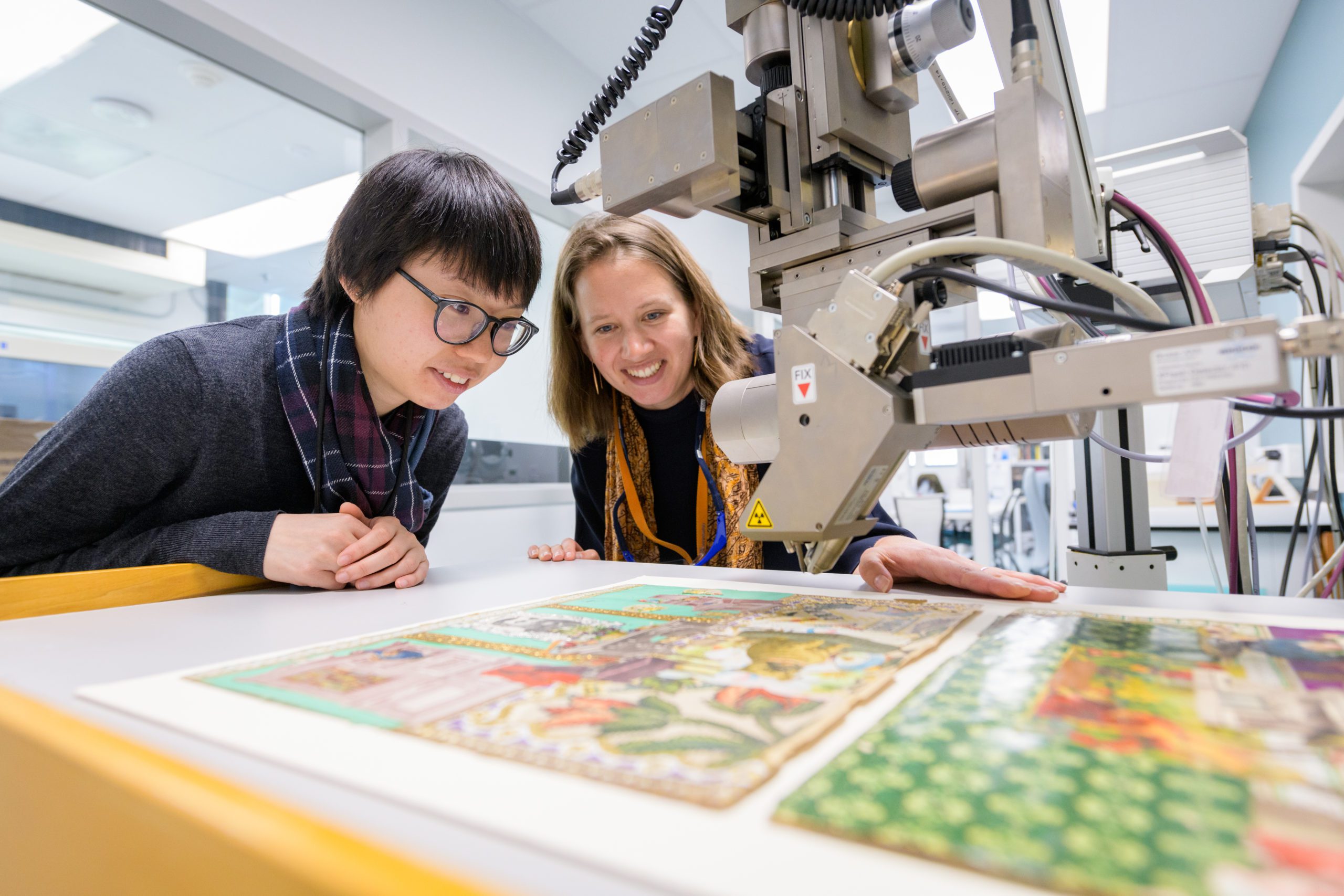
Image Caption: Dr. Rosie Grayburn (right) and graduate student Yan Ling Choi examine the elemental composition of the pigments on “Helen’s Scrapbook House” using non-destructive X-ray fluorescence analysis.
The Winterthur/University of Delaware Program in Art Conservation (WUDPAC) is a graduate-level program jointly sponsored by the University of Delaware and Winterthur. It is a three-year course leading to a master of science in art conservation. The faculty is composed of Winterthur conservators in the Conservation Department and faculty members from the University of Delaware Art Conservation Department.
Faculty and students use fifteen well-equipped conservation studios, laboratories, examination rooms, and workshops in the Louise du Pont Crowninshield Research Building at Winterthur. This includes one of the largest and best-equipped museum analytical laboratories in the country. Winterthur’s comprehensive collection of early American art, architecture, furniture, textiles, silver, pewter, ceramics, glass, paintings, prints, and library and archival materials is world-renowned. The University of Delaware houses art studios for reconstructing historic techniques, science laboratories, a conservation laboratory, and administrative offices.
The WUDPAC curriculum is designed to develop essential skills in critical thinking, leadership, and communication; improve hand skills; introduce a spectrum of techniques and analyses in the assessment, preventive care and ethical treatment of cultural property; and develop an awareness of conservation literature, connoisseurship, and the history of technology of cultural property.
The curriculum is also designed to produce scientifically literate graduates capable of understanding the fundamental chemical and physical properties of art and cultural materials and the technology of their manufacture, deterioration, and preservation, as well as graduates who will be able to draw from and add to the scientific literature in their profession. A graduating student is prepared to work as a successful entry-level conservation professional. As part of their education, students share their work during conservation tours of the Winterthur conservation studios and laboratories and advise members of the public during monthly conservation clinics on the museum grounds. During the summers, students undertake an eight-week project at an institution, conservation laboratory, or historic or archaeological site. The entire third year (or internship year) is spent under the supervision and mentoring of conservation professionals at one or more host institutions or private laboratories, where the student functions as a productive staff member.
On-site Conservation Student Research & Activities
Student Seminars
Seminars featuring current WUDPAC students, faculty, and outside professional speakers provide broader insights into preservation issues and practices. These seminars are presented on Wednesday afternoons during the academic year and are open to the public.
Materials Research Projects
Master’s degree-level students complete their second-year science coursework in Winterthur’s Scientific Research and Analysis Laboratory (SRAL). A year-long materials research project ensures that students have working familiarity and hands-on experience with instrumental methods of analysis as they relate to the activities of collections, interpretation, and conservation. Late in the spring semester, the students report on their results in a half-day symposium that is open to the public.
Outreach
WUDPAC students and faculty are committed to meaningful and community-based work that addresses societal challenges, from equity and inclusion to sustainability, climate change, and health and well-being, as well as work that contributes to the growth of conservation research and practice.
As part of the museum’s and the university’s missions of service, WUDPAC students participate in regional and national public service initiatives, conservation tours of the Winterthur laboratories, and on-site conservation clinics, during which faculty and students share their knowledge about the care of cultural heritage, including family treasures, with collectors, curators, caretakers, or scholars. Faculty and students also contribute to local and global engagement projects, and WUDPAC is a long-standing partner in diversity initiatives that bring students from underserved communities to Winterthur Museum, Garden & Library for hands-on introductory courses in conservation and collections care, among other outreach activities.